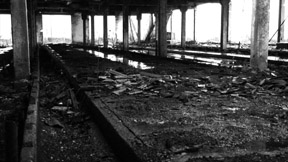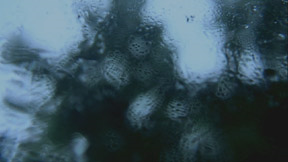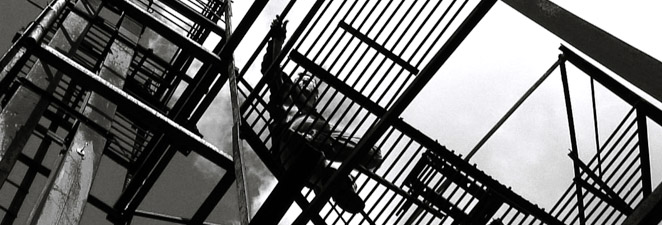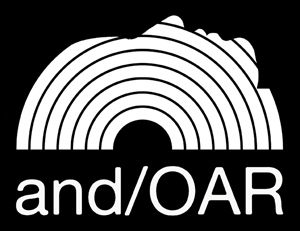Program List:
01. Sound Aspects Of Material Elements
02. Mimema
and/OAR, Maaheli Editions and Paleosol Edition are extremely pleased to
present two films by sound artist John Grzinich: Sound Aspects Of Material
Elements & Mimema which features cameo appearances by Patrick
McGinley (aka Murmer), HItoshi Kojo (aka Spiracle), Eamon Sprod (aka
Tarab), Jim Haynes, Toomas Thetloff, Maksims Shentelevs, Kaspars
Kalninsh, Evelyn Muursepp, Mari Jõgiste, Vivian Bohl and Pärt Ojamaa.

Sound Aspects Of Material Elements
Black & White, 57 minutes HD, 16:9 Aspect Ratio
Concept, sound, camera, editing: John Grzinich
Equipment and support: MoKS - Center for Art and Social Practice, Mooste,
Estonia. Collaborative recordings made with: Patrick McGinley, Jim Haynes,
Toomas Thetlof, Maksims Shentelevs, Kaspars Kalninsh, Eamon Sprod,
Hitoshi Kojo, and Evelyn Müürsepp.
Sound Aspects Of Material Elements is a the film that shows a specific
approach to the artistic use of sound, covering a 3 year period (2006-2009) of
the author's personal research and collaborations with a number of close
colleagues. What we hear and see reveals how much our ability to listen with
a creative ear, helps us re-interpret and build new relations to what
surrounds us. Using sound as the primary signifier. The film documents
in-situ processes of exploration and sonification of the landscape along with
various material, objects and structures found there. All the sounds captured
formed the basis for each shot emphasizing how the combinations of certain
materials (metal, wood, glass) along with natural elements (water, wind fire),
transforms our perception of even the most common everyday places or
situations.
"Sound Aspects of Material Elements by John Grzinich is a highly unique film,
an elegant collection of location sound explorations captured over a three-year
period. Empty landscapes of blowing grass and drifting clouds, slight
manipulations of abandoned and natural objects, solo engagements with
architectural structures, duos and occasionally larger groups of participants
“playing” found materials. In each case, all sounds are sourced within a location,
augmented and activated through simple acoustic techniques – tubes, wires,
mallets and contact mics. Each 'situation' becomes a kind of instrument, each
'place' is approached as a rich source of sonic matter. This film finds itself
between ‘sound art’ and cinema. Unlike most movies, the film follows strict
limitations in using only location-based, real-time sound capture. On the other
hand, there is strongly disjunctive relationship between what we see and what
we hear because of the predominant use of unusual miking techniques. The
shots themselves are often medium to long, and place the objects or figures
within the landscape – desolate Estonian fields, ramshackle barns, windswept
telephone wires, nighttime fires, abandoned and corroded metal tanks or
girders. The sounds, however, are not only of, but inside the location being
shown. We hear into spaces and materials through the careful use of contact
mics or the placement of microphones inside containers, tubes and vessels.
These decisions amplify, magnify and distort the sonic landscape in relation to
what is seen. It can feel like existing on two levels at once. Sound Aspects of
Material Elements doesn’t illustrate, interpret or elaborate upon sound with
image, it just shows - demonstrating the elements at play in a particular
arrangement or situation. At the same time, the links between sound and image
are more than just causal. They are the result of careful exploration, fine-tuned
framing, and a delicate balance of the haphazard and the instigated." (Seth Nehil)

Mimema
Color, 24:38 minutes, HD 16:9 Aspect Ratio
Concept, sound, camera, editing: John Grzinich
Equipment and support: MoKS - Center for Art and Social Practice, Mooste
Estonia.
Mimema is a meditation on states of liminality, of being in stasis, drifting
in-between above and below, night and day, inside and out. Mimema started
out as a sound composition and grew into a series of images that reflected
my desire to invert the world around me by capturing the 'real' and making it
'imaginary', Much like a mirror that reflects the shifting states of human
cognition we encounter moment to moment. Mimema is the blur between
what we sense and what we construct as understanding, appearing as
much a body as a fluid or boundary as a state of dissolution.
"One way to describe John Grzinich's film Mimema would be 'hypnagogic
drone poem cinema'. Watching sleeping floaters dream in the eye of the
camera. The sound and visual elements work together in such a way, that it's
difficult to keep from falling under its hypnotic spell. Very rich and deep.
Meanwhile, Sound Aspects Of Material Elements is a unique cinematic
documentary experience that says much without uttering a word. For the less
initiated, it not only teaches sound appreciation in an inspiring way, but also
demonstrates where sound sources found in much of today's field
recording-based sound art compositions initially come from. Certainly a
landmark moment for and/OAR and one of the most prized releases in the
label catalog." (Dale Lloyd)
John Grzinich has been conducting his own forms of sound research for
over 15 years, including field recording, kinetic sculptures,
electro-acoustic composition, performance, videography, group workshops
and exercises in listening. Currently he lives in Estonia and works as a
program and technical coordinator for MoKS, a non-profit artist-run
center. He has published CDs of his sound works on international labels
such as: SIRR, Mystery Sea, Staalplaat, Erewhon, Intransitive, Cut,
Elevator Bath, Invisible Birds, Semper Florens and others. Documentation
and examples of his work can be found at: http://maaheli.ee/
Reviews
_________________________________________________________________________________
The Wire (October 2012)
John Grzinich is known for his work with music and sound, but Sound
Aspects Of Material Elements and Mimema, for which he's credited with
camera and editing, prove that his eye is as keen as his ear. While sound is
the subject matter of the first film, and something like the driving force of , or
inspiration for the second, both present elegantly composed images of
landscapes both remote (stark rural / industrial vistas from the American
artist's current home of Estonia) and macrocosmic (insects, flowers, water
and skin), within which it's tempting to get pleasurably lost.
The prosaic title of Sound Aspects Of Material Elements suggests that this
kind of sensual wallow isn't quite what Grzinich had in mind. The film is
made up of a series of field recordings and site-specific performances
presented in short sequences, like tracks on an album, shot mostly with a
static camera. The sound is as satisfyingly clear as the high contrast black
and white visuals. We hear each recording for a few seconds before we see
its provenance, which invites some kind of analysis on the part of the viewer,
if only in the realm of guessing which combination of wires, wind, water and
microphone technique might result in that cavernous, bowed bass sound.
But the larger question Grzinich sets up in the film concerns what constitutes
composition and creation when dealing with field recordings - what is played
and what's found, and how does an artist navigate around those two poles?
In Sound Aspects Of Material Elements he shows himself clearly doing the
former, rubbing miked-up stones over a metal water tank, and illustrates the
latter in a Tarkovsky-like sequence in which rain drips through the roof of a
corrugated iron barn. But the instances in between - such as a recording of
waves coursing back and forth through metal pipes placed carefully on the
shoreline of a lake - are the most striking, with the tension between the
natural movement of the water and the presence of the artist made clear in a
way that isn't always apparent in the sometimes anodyne field of purely
visual Land Art. It helps that this one also sounds remarkable, unplaceable,
a sort of undulating, alien drone with a percussion track of shingle-suck and
clattering glassy pebbles.
The succession of deserted spaces, which can get a little soporific, is neatly
interrupted by footage of a contact-miked ants' nest, which sounds like a
frantic kitchen full of scraped plates and dropped knives. This is a welcome
moment of action as is a performance for tuning forks and amplified
surfaces that Grzinich shoots as a kind of ballet for disembodied arms.
Physical presences are more to the fore in Mimema, a shorter film which
dreams its way through an Estonian 'white night' in which the sun never
really sets with a soundtrack of organ drones reminiscent of Time Hecker.
The strange liminal zone of Spring is reflected in the slow development of the
music, which ebbs and flows around a man and a woman, shot in intimate
close-up, floating in a dark lake. But while they drift tranquilly, eyes closed,
suspending themselves gravitationally and temporally, other life continues at
its allotted pace: boatmen skate on the water's surface, plants bud out new
life, mist rises and snow melts. Grzinich observes all these processes with a
dispassionate equality that doesn't quite mask a deep, tactile affection for his
adopted home. (Frances Morgan)
The Field Reporter (September 2012)
Electrical power-lines humming above open farmlands, lifeless branches
hitting ice-coated wires, waves echoing as they lap inside pipes; these are
only a few of the sounds captured by John Grzinich in “Two Films”. This
mesmerizing DVD, released by the and/OAR label, unveils the sonic life that
envelops us, unheard without the aid of microphones or the inclination to
listen. Born in New York, and currently living in Estonia, Grzinich has been
working with sound composition since the early 1990s. Only more recently
has he seriously focused on film as a creative medium.
It is the bleak landscape of Estonia that features in “Sound Aspects Of
Material Elements”, the first of the two films. In grainy black and white footage
the audience is privy to long static shots of abandoned spaces and beautiful
wastelands. As we observe the frozen Estonian countryside’s lop-sided
power-lines and decaying farm structures it is easy to imagine a localized
apocalypse occurred here decades before. All visual cues in the film suggest
a blanket of silence pervades the area, however it is through Grzinich’s well-
trained ear and microphone work that this assumption is shown to be false.
Electricity continues to flow through the power-lines, its lethal charge being
heard in low oscillating drones; water drips from the ceiling of an abandoned
cement building, falling into pools whose varying depths create a polyphonic
melody; a dormant tree branch sways in the breeze, delicately striking a wire
at irregular intervals.
The sounds that Grzinich captures are mesmerising, each are featured for
less than four minutes at a time. The recordings seamlessly fade in and out
to create a single composition. “Sound Aspects Of Material Elements” also
shows that Grzinich is not content to compose solely through the use of
found sound. In several shots we see Grzinich interacting with objects in the
environment. Pieces of detritus become objects to strike, scratch and record.
A huge metal tank echoes as three men scrape its side; an old tower creaks
and groans as Grzinich climbs its damaged rungs; in a beautiful scene a
metal surface amplifies the sound of tuning forks as they are slowly placed
upon it.
In other recordings Grzinich uses creative techniques to present new ways of
listening to familiar objects. Microphones are inserted into bottles and then
placed next to open fires, the pop and crackle of burning wood echoes inside
their fragile glass chambers; waves and dried grass are heard through the
distorting effect of long tubes; a wire is stretched across a stream, its
reverberating tone shifting under the bubbling flow of water. Explaining his
approach Grzinich says “All the sounds captured formed the basis for each
shot emphasizing how the combinations of certain materials (metal, wood,
glass) along with natural elements (water, wind, fire), transforms our
perception of even the most common everyday places or situations”. After
watching this we listen again to these primeval elements with a renewed
vigour.
“Mimema”, the second of the two films, is described by Grzinich as “the
soundtrack for the half submerged floaters drifting at dusk on the still lakes”.
An organ softly holds long wavering notes alongside recurring images of
foliage, cobwebs, foggy countryside, and a face calmly immersed in water.
Visually “Mimema’s” pace of editing sometimes runs ahead of the
composition, nonetheless an emotional impression resonates long after the
film reaches its end.
“Two Films” is a profound work of art, throughout its duration we are
spellbound. As the films unfold we sit mesmerized by the sounds and
images emanating from the screen. It is a pleasure to watch Grzinich in the
field, the visual connection with the sounding objects providing a greater
appreciation for his work. After viewing “Two Films” it is hard not to imagine
the sonic potentials that lie around us, untapped, waiting for a microphone to
be directed towards them. (Jay-Dea Lopez)
Vital Weekly (August 2012)
The label Alluvial Recordings is apparently no more - I am not sure why - but
now there is Paleosol Edition, and this first release is done in collaboration
with and/OAR, and is a DVD of two films of composer John Grzinich, which I
think is an interesting thing. Just what would it be? Animation stuff, a
documentary, a concert or, as it in fact turns out to be, a film that displays the
field recordings being recorded. We see someone (perhaps Grzinich
himself?) beating a pole, a campfire, electrical wire in a field, someone
scraping large empty metal containers, and sometimes no human
interference at all, like a stream and what seems to be a wire inside. All of
this is short movements in 'Sound Aspects Of Material Elements', which
lasts some fifty-six minutes. Sometimes I think I am being fooled and I see
something but believe that I hear something else. That's always a great thing
I should think, but perhaps I like this sort of illusion very much. The nice thing
about this film is that following every segment, the screen blacks out and we
hear what's coming next, but yet not see it, so your mind starts guessing - I
was wrong in almost of all these cases. Shot in austere black and white, this
one is great. The other film is much shorter and called 'Mimema'. Here I
don't think its about the action to generate material, but a more poetic film
with people floating in water set against a great piece of drone music. Maybe
this is all about hearing 'below the surface'? I am not sure, but it looks and
sounds great. More poetic, less documentary like than the other one. Two
quite different approaches to film, but both work quite nice. (Frans de Waard)












